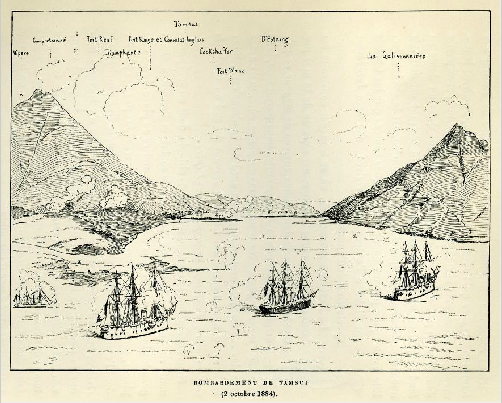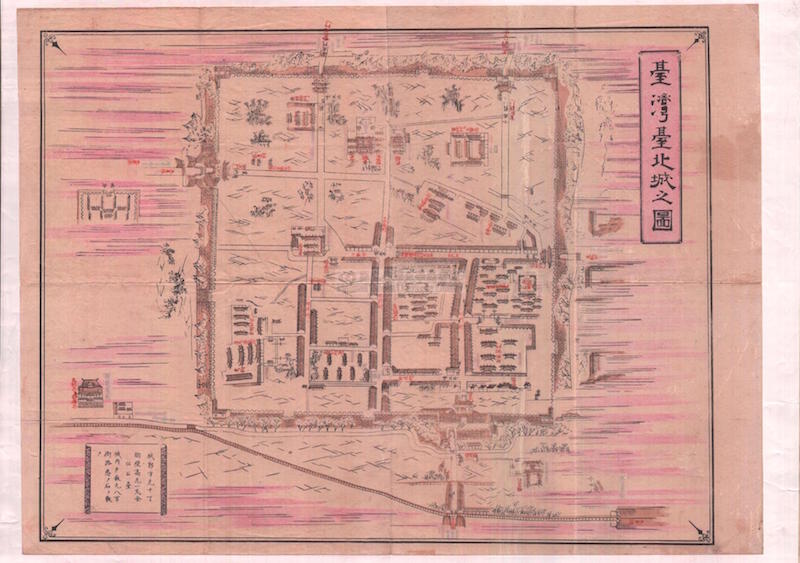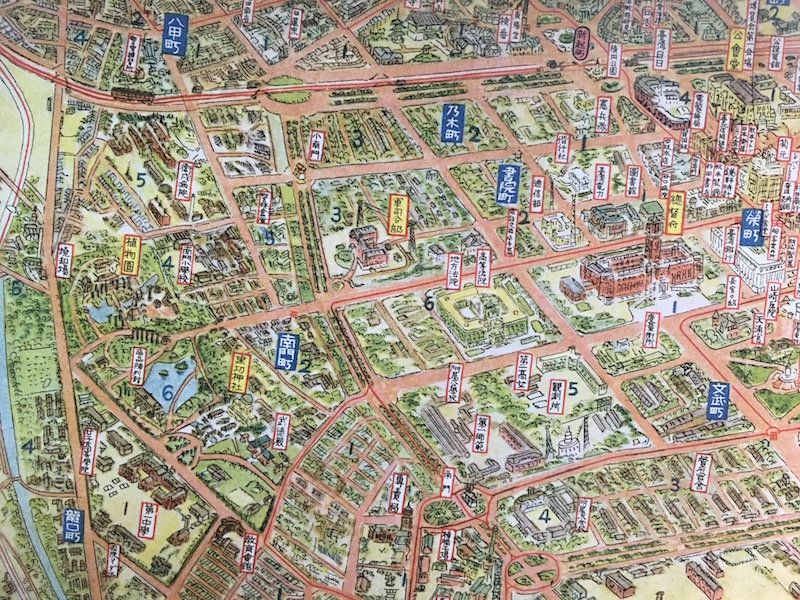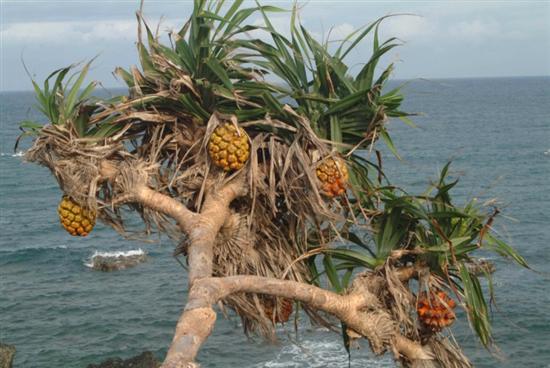
Pages 123-127
A reading route prepared by Hannah (FLAC), Sarah, You, Sam
Image (left): Yucca/screw pine/pandanas
Image Credit: Kinmen County Agricultural Research Institute
The Chinese hibiscuses and yuccas in the novel remind the author of her home. When she sees either the hibiscus or yucca, she thinks of the history of Taiwan, or is drawn out of the tourist bus to explore Taiwan.
“Beyond the yuccas and the Chinese hibiscuses was the ocean.” (pg 124)
“穿过林投与黄槿便是海.” (页142)
[/et_pb_vertical_timeline_item] [/et_pb_vertical_timeline][et_pb_vertical_timeline admin_label=”Timeline – Vertical” use_border_color=”off” border_color=”#ffffff” border_style=”solid”] [et_pb_vertical_timeline_item title=”Stop 2″ use_read_more=”off” animation=”off” text_font_select=”default” text_font=”||||” headings_font_select=”default” headings_font=”||||” use_border_color=”off” border_style=”solid”]
“In particular, the Chinese hibiscus, known for reaching over walls from under eaves, left a deep impression on the group of young and middle-aged men who arrived in 1949, and the Portuguese and Spaniards who came to save souls and obtain pepper 300 years earlier.” (pg 118)
“尤其那总从墙头檐角探出头来的朱槿,四九年来的那批青壮汉子和三百多年前为了解救灵魂和取得胡椒而来的葡萄牙人四班牙人.” (页138)
[/et_pb_vertical_timeline_item] [/et_pb_vertical_timeline][et_pb_vertical_timeline admin_label=”Timeline – Vertical” use_border_color=”off” border_color=”#ffffff” border_style=”solid”] [et_pb_vertical_timeline_item title=”Stop 3″ use_read_more=”off” animation=”off” text_font_select=”default” text_font=”||||” headings_font_select=”default” headings_font=”||||” use_border_color=”off” border_style=”solid”]
“The French fell for the trick and entered a dense forest of yucca and Chinese hibiscuses, where their machine guns and cannons were ineffective, leaving them no choice but to engage in hand-to-hand combat with knives.” (pg 124-125)
“法军果然进人长满林投与黄槿的密林,无法施展机枪火炮的优势,只得与守军挥刀白刃.” (页142)
[/et_pb_vertical_timeline_item] [/et_pb_vertical_timeline][et_pb_vertical_timeline admin_label=”Timeline – Vertical” use_border_color=”off” border_color=”#ffffff” border_style=”solid”] [et_pb_vertical_timeline_item title=”Stop 4″ use_read_more=”off” animation=”off” text_font_select=”default” text_font=”||||” headings_font_select=”default” headings_font=”||||” use_border_color=”off” border_style=”solid”]
“In your flurried and flustered state, your gaze fell upon some Chinese hibiscuses outside the window – there beyond the screw pine grove and the Chinese hibiscuses was the ocean – so you decided to get off at the next stop” (pg 205)
“慌乱中,你瞥见黄槿–––穿过林投与黄槿便是海–––便果决地在下一个停靠站下车.” (页198)
[/et_pb_vertical_timeline_item] [/et_pb_vertical_timeline][et_pb_vertical_timeline admin_label=”Timeline – Vertical” use_border_color=”off” border_color=”#ffffff” border_style=”solid”] [et_pb_vertical_timeline_item title=”Stop 5″ use_read_more=”off” animation=”off” text_font_select=”default” text_font=”||||” headings_font_select=”default” headings_font=”||||” use_border_color=”off” border_style=”solid”]
“Mounting the stage in July were the alystegias, which were in fact impomoea, which could be easily seen on the sandy beach with pandanas and Chinese hibiscuses – the driver failed to knock you out, and you stumbled off the bus at Nissin-cho near Taihei-cho.” (pg 210)
“七月,紫花军配昼颜登场,其实就是穿过林投黄槿海滨沙地上常见的马鞍藤——司机没能撞昏你,放你跌跌撞撞在日新町近太平町下车。” (页200-201)
[/et_pb_vertical_timeline_item] [/et_pb_vertical_timeline][et_pb_vertical_timeline admin_label=”Timeline – Vertical” use_border_color=”off” border_color=”#ffffff” border_style=”solid”] [et_pb_vertical_timeline_item title=”Stop 6″ use_read_more=”off” animation=”off” text_font_select=”default” text_font=”||||” headings_font_select=”default” headings_font=”||||” use_border_color=”off” border_style=”solid”]
“The houses with tiled roofs covered by Chinese hibiscus had been official property and concessions during the Qing dynasty, then became administrative offices and official dormitories once the Japanese took over. Again, because great men should all be like that.” (pg 206)
“黄槿掩抱着炼瓦屋顶的是清代的官有地租借区,日人领有后的行政机关和官舍。仍然是大丈夫当如是耳吧。” (页198)
[/et_pb_vertical_timeline_item] [/et_pb_vertical_timeline]
Chinese Hibiscus
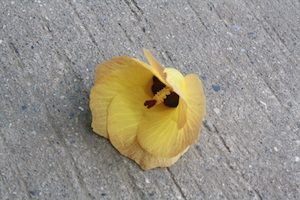
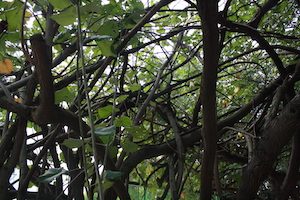
Image Credit: Leah Suffern
朱槿
Here, 朱槿 is incorrectly translated as Chinese Hibiscus (黄槿). Its scientific name is Hibiscus rosa-sinensis, and it is a bright red color. So, although this quote follows with the pattern of the Stop 3 quote, because the flowers are tying the past with the present, this is not the same flower as the Chinese Hibiscus (黄槿, Hibiscus tiliaceus). 朱 also has several cultural connotations: it usually represents South, it means an especially bright red color (as opposed to 红, which is a more modern word), and it was the surname of the Ming Dynasty emperors. Some of the 朱 people emigrated to Taiwan during the Ming Dynasty.
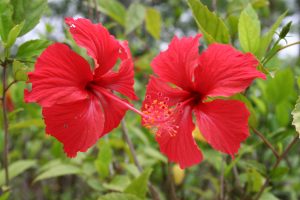
Image credit: http://tcmp.cpami.gov.tw/
Analysis for Stop 4: 穿过
In the translation, 穿过 (through) is not directly translated in the English version, although its presence is important because it mirrors the 穿过 in the topic sentence “穿过林投与黄槿便是海.”
1885 La Marine a Formose -- Bombardement de Tam-sui
Analysis for Stop 6: 丈夫
丈夫, which can also be translated as “husband” is used here to describe a man in power.

Pages 127-134
A reading route prepared by Hannah (FLAC), Sarah, You, Sam
Image: North Gate tyrannized by an overpass
Image Credit: udn.com
The author recounts various incidences throughout the novel where the ruling power in Taiwan had destroyed existing structures to make way for new ones. These accounts range from the Qing government to the modern (1996) Democratic Progressive Party Mayor.
Timeline of “Laying Waste:”
- Manchu Qing: talk in the court
- Japanese: no different from Manchu Qing
- KMT: North Gate tyrannized by an overpass, Japanese Shinto shrines would be cleared away, Meiji Bridge waiting to be demolished
- DPP Mayor: eucalyptus trees had been taken down
“When the Qing government took over Taiwan, there was talk in the court about laying waste to it.” (pg 127)
“清人得台,廷议欲墟其地.” (页144)
[/et_pb_vertical_timeline_item] [/et_pb_vertical_timeline][et_pb_vertical_timeline admin_label=”Timeline – Vertical” use_border_color=”off” border_color=”#ffffff” border_style=”solid”] [et_pb_vertical_timeline_item title=”Stop 2″ use_read_more=”off” animation=”off” text_font_select=”default” text_font=”||||” headings_font_select=”default” headings_font=”||||” use_border_color=”off” border_style=”solid”]
“The Japanese were no different from the Manchu Qing court; if it wasn’t “perhaps we should level the place,” it was “sell Taiwan for a billion dollars.”” (pg 147)
“日人跟清人一样,不是“廷议欲墟其地” 就是 ”一亿元台湾卖却论。” (页158)
[/et_pb_vertical_timeline_item] [/et_pb_vertical_timeline][et_pb_vertical_timeline admin_label=”Timeline – Vertical” use_border_color=”off” border_color=”#ffffff” border_style=”solid”] [et_pb_vertical_timeline_item title=”Stop 3″ use_read_more=”off” animation=”off” text_font_select=”default” text_font=”||||” headings_font_select=”default” headings_font=”||||” use_border_color=”off” border_style=”solid”]
“Within the next two or three years, the remaining Japanese Shinto shrines would be cleared away from Maruyama and replaced by the Chinese palace-style Grand Hotel for foreign VIPs.” (pg 128)
“其后两三年,山上清除神社遗迹,建起中国宫殿饭店,专门用来接待国宾。”
[/et_pb_vertical_timeline_item] [/et_pb_vertical_timeline][et_pb_vertical_timeline admin_label=”Timeline – Vertical” use_border_color=”off” border_color=”#ffffff” border_style=”solid”] [et_pb_vertical_timeline_item title=”Stop 4″ use_read_more=”off” animation=”off” text_font_select=”default” text_font=”||||” headings_font_select=”default” headings_font=”||||” use_border_color=”off” border_style=”solid”]
“Meiji Bridge—later you learned that’s what it was called. The brass lamps from the Meiji Bridge had been purchased during a round of reconstruction by Li Meishu, who installed them in a Buddhist temple in Sanxia. The handsome, straight, and even bridge, now overshadowed by a new one, was waiting to be demolished. The new rulers, who had criticized the ancien régime as an occupying power, had been in office four years, and the way they behaved was exactly like an occupying power.” (pg 144)
“明治桥——你后来知道它原来叫明治桥,桥上的铜灯早在一场拆建时给李梅树买了放置在三峡的祖师庙了。平直美丽的桥被一座新桥压着待拆毁,批评以往时外来政权的新统治者人马已执政四年,所作所为与外来政权一样。”
[/et_pb_vertical_timeline_item] [/et_pb_vertical_timeline][et_pb_vertical_timeline admin_label=”Timeline – Vertical” use_border_color=”off” border_color=”#ffffff” border_style=”solid”] [et_pb_vertical_timeline_item title=”Stop 5″ use_read_more=”off” animation=”off” text_font_select=”default” text_font=”||||” headings_font_select=”default” headings_font=”||||” use_border_color=”off” border_style=”solid”]
“Back then, North Gate had yet to be tyrannized by an overpass, so you could walk past it casually, feeling like one of your ancestors heading out of town a century before.” (pg 113)
“那时的北门尚未被任何高架路凌虐,你们轻松行经它旁边,便像百年前的先民一般有出城的感觉。”
[/et_pb_vertical_timeline_item] [/et_pb_vertical_timeline][et_pb_vertical_timeline admin_label=”Timeline – Vertical” use_border_color=”off” border_color=”#ffffff” border_style=”solid”] [et_pb_vertical_timeline_item title=”Stop 6″ use_read_more=”off” animation=”off” text_font_select=”default” text_font=”||||” headings_font_select=”default” headings_font=”||||” use_border_color=”off” border_style=”solid”]
“Directly across from it, in Lane 243, Jinhua Street, a row of 50-year-old eucalyptus trees had been taken down by his Excellency the Mayor, who had never stopped crowing about how much he loved this island and this city. Even more ironic was that the place was immediately turned into a small community park with tiny trees.” (pg 153)
“它正对的金华街二四三巷一列五十年以上的桉树也被口口声声爱这岛爱这城的市长大人给砍了,并很讽刺地当场建了个种满小树的社区小公园。”
[/et_pb_vertical_timeline_item] [/et_pb_vertical_timeline][et_pb_vertical_timeline admin_label=”Timeline – Vertical” use_border_color=”off” border_color=”#ffffff” border_style=”solid”] [et_pb_vertical_timeline_item use_read_more=”off” animation=”off” text_font_select=”default” text_font=”||||” headings_font_select=”default” headings_font=”||||” use_border_color=”off” border_style=”solid” title=”Stop 7″]
“When the Qing government took over Taiwan, there was talk in the court about laying waste to it.” (pg 179)
“清人得台,廷议欲墟其地.” (页180)
[/et_pb_vertical_timeline_item] [/et_pb_vertical_timeline]
Analysis for Stop 1 and Stop 2
In the translated version of these two quotes, there are no phrases that the two have in common. But, in the original version, we can see that they both contain “廷议欲墟其地,” and the translator chose to use “level the place” instead of “laying waste to it,” which is a more direct translation. By doing this, the phrase in Stop 2 loses the emphasis placed by the mirroring of the phrase which lessens its effect to the reader. I think “laying waste” is a better translation, since it has a more severe and visceral imagery attached to the words.

Analysis for Stop 7
The quote in Stop 7 is the exact same as the quote that appears to mark the section of the book, both in the translated and original text. However, in Stop 7 the quote follows You’s story of A’s apartment that You had borrowed; how over the years it had deteriorated until it was leveled. So, in this case, the Qing government is the new government in Taiwan (DPP) that is tearing down the buildings that You had lived in in her younger years.

